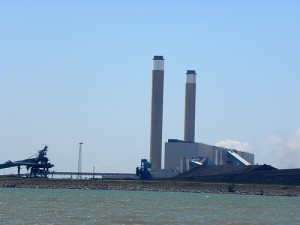 By Mark James, CCCL Legal Intern
By Mark James, CCCL Legal Intern
On January 8, 2014, the sole remaining coal-fired generating plant in Ontario burned its last tonne of coal. With the closure of the Nanticoke Generating Station, Ontario ended its long-term relationship with coal-fired generating plants. To further its commitment to a coal-free future, the government has recently introduced a bill to make Ontario the first jurisdiction in North America to permanently ban stand-alone coal-fired electrical generating plants.
Fulfilling the government’s 2003 election promise to close Ontario’s five coal-fired generating plants has been a long and tenuous process. The closures were originally slated for 2007 but they were twice delayed; first until 2009 and then again until the end of 2014.
On November 25, 2013, the minority Liberal government took another step to secure a coal-free future. They introduced Bill 138, Ending Coal for Cleaner Air Act, 2013 which bans coal use at the four remaining stand-alone coal-fired generating facilities in Ontario and prohibits the use of coal for any new stand-alone electricity generating facilities. Since the existing plants have either been retired or are being converted to burn biomass, the bill will prevent them from ever being restarted as coal-fired power plants. To pass the bill, the minority government will require the support of the opposition parties. It is not clear whether this support can be secured, as a potential spring election looms.
The imminent closure of the plants has provided Ontario with an opportunity to revamp its electrical system. In the last decade, Ontario has increased both the supply of electricity and the reliability of its energy system by diversifying its sources of electricity. In 2003, when the closures were first announced, Ontario was importing 3,800 MW of power and the reliability of its power system was below the North American standard. The coal-fired plants targeted for closure were producing 6,100 MW of power or 25% of Ontario’s total power output. Since 2009, the province has added more than 7,100 MW of new renewable energy projects. New and expanded hydroelectric generating plants, small-scale solar PV, and wind power have allowed Ontario to transition from a net-power importer to a surplus power producer. In fact, Ontario has managed to make the transition while boosting its reliability rating above the North American standard.
A coal-free electrical system is giving additional benefits to the residents of Ontario. When financial, health, and environmental costs of burning coal are calculated, estimated savings from no longer burning coal approach $4.4 billion/year. Greenhouse gas emissions from electricity generation are projected to drop by more than 90% from 2005 levels by 2015. Ontario is already reaping the benefits of the transition. In 2011, sulphur dioxide and nitrogen oxide emissions from power plants were 93% and 85% lower than they were in 2003. In 2011, Ontario’s coal-fired plants emitted the lowest amount of mercury recorded in the past 45 years. In 2005, Ontario had 53 smog days and in 2013 there were only 2 smog days.
Ontario turned a political promise into a complete overhaul of its electrical system. Eliminating coal has allowed the province to grow its renewable energy sector, boost its conservation programs, and clean up its air quality. With legislation to make the shift permanent, Ontario is charting a course that firmly establishes it as a clean energy leader in North America. Let’s hope that other states and provinces make the same decision to go down the path to a clean energy future.
Photo of the recently shuttered Nanticoke coal-fired generating plant, courtesy of JasonParis.



